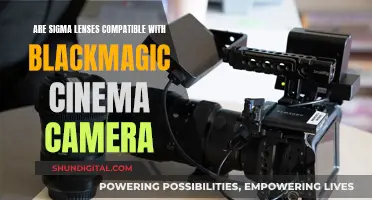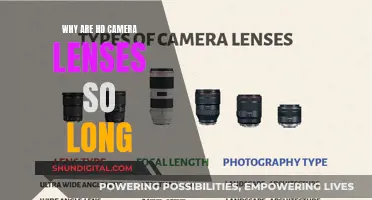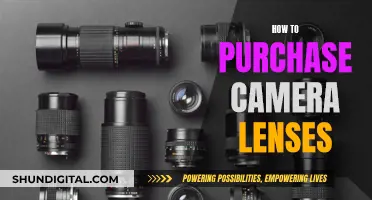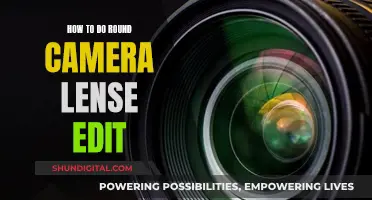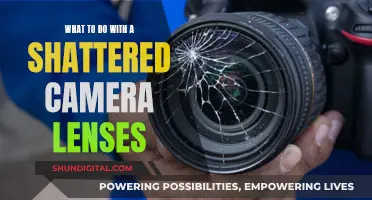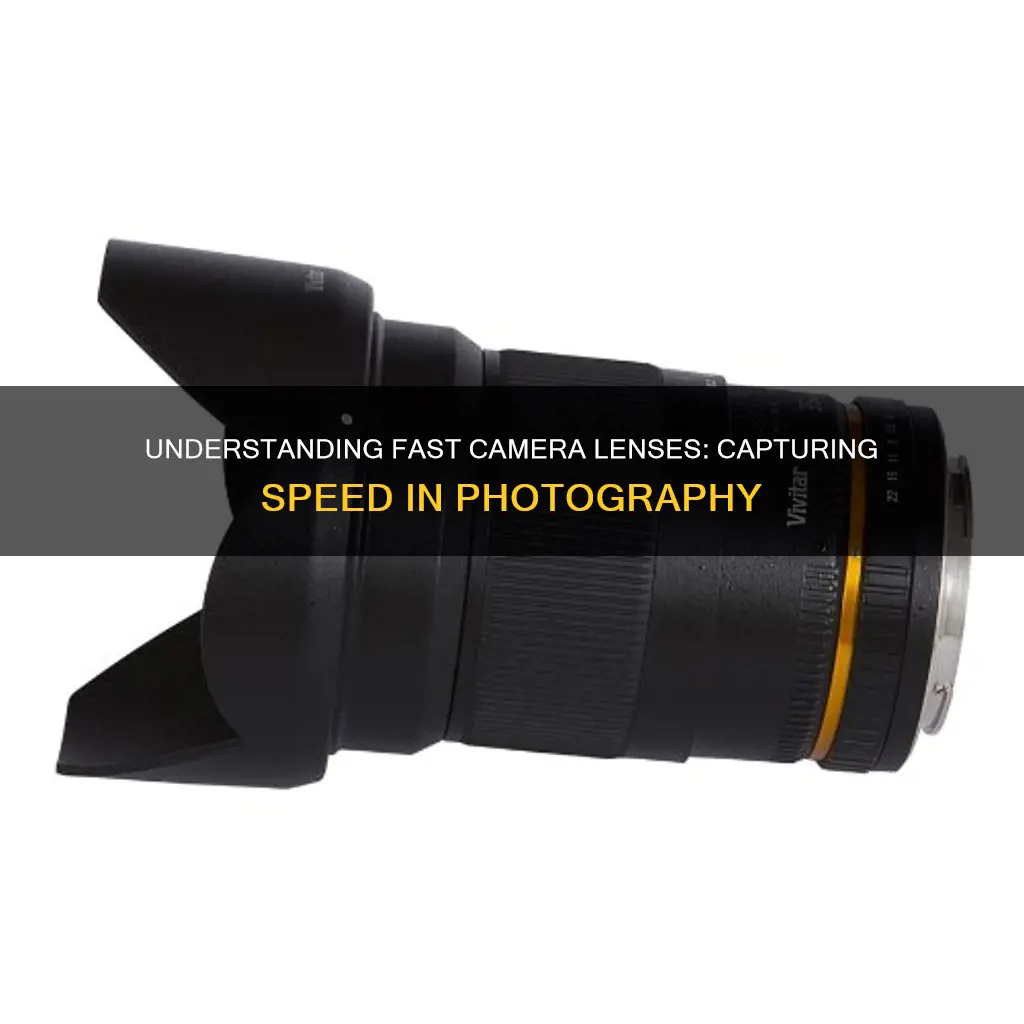
A fast camera lens is one that has a large maximum aperture, allowing more light to reach the camera's sensor. This enables faster shutter speeds, even in low-light conditions, and can create a shallow depth of field, blurring the background and removing distractions from the scene. The aperture is represented by an f followed by a number, with larger apertures having smaller numbers like f/1.4, f/1.8, and f/2.8. These lenses offer advantages such as handheld shooting, improved autofocus, and creative visual effects, but they tend to be heavier, bulkier, and more expensive than slower lenses.
| Characteristics | Values |
|---|---|
| Aperture | Large maximum aperture, often displayed as f/1.4, f/1.8, f/2.8 |
| Shutter Speed | Faster shutter speeds |
| Lighting | Allows more light to reach the camera's sensor |
| ISO | Can keep the ISO down, preventing noise |
| Depth of Field | Creates shallow depth of field effects |
| Focus | More responsive autofocus system |
| Weight | Heavier and bulkier than slower lenses |
| Cost | More expensive than slower lenses |
What You'll Learn

Fast lenses allow for faster shutter speeds
A "fast" camera lens is one that has a large maximum aperture, which is often displayed as an "f" followed by a number. A large maximum aperture will be a small number, such as f/1.4, f/1.8, or f/2.8. A fast lens allows for faster shutter speeds because it lets in more light, which is especially useful in low-light situations.
The aperture is the hole in the lens that opens and closes depending on your camera settings. A wide aperture has certain special effects, and these are only offered by fast lenses. Wide apertures correspond to low f-numbers, while narrow apertures correspond to high f-numbers. So, if you see a lens with f/1.8 or f/2.8 in its name, you know it's a fast lens, whereas a lens with f/5.6 would be considered slow.
The wider the aperture (or the lower the f-number), the more light is let in, and the faster the shutter speed can be. This is similar to filling a glass of water from a tap—if you only open the tap slightly, it takes longer to fill the glass than if you open it to full volume.
Fast lenses are particularly useful in situations where you need to shoot handheld or capture moving subjects in low light. They are also beneficial when you want to avoid using a tripod, such as in cathedrals or busy locations like museums. Additionally, fast lenses can help keep the ISO down, preventing noise in your images.
Another advantage of fast lenses is their ability to create a shallow depth of field effect, blurring the background and removing distractions from the scene. This is especially useful in portrait photography to visually separate the subject from the background.
However, it's important to note that fast lenses also have some drawbacks. They tend to be more expensive, heavier, and bulkier than slower lenses. Additionally, they require careful focusing to ensure the autofocus doesn't capture the wrong part of the shot.
CCD Camera Lenses: Color Corrected or Not?
You may want to see also

A wider aperture lets in more light
The aperture of a lens is the opening through which light passes into the camera. The wider the opening, the more light can reach the camera sensor, which in turn affects the exposure of the image. The aperture needs to decrease or increase to achieve the correct exposure – that is, a clear image that's not too dark or too washed out – in different lighting conditions.
The aperture stop generally depends on the object point location. On-axis object points at different object planes may have different aperture stops, and even object points at different lateral locations at the same object plane may have different aperture stops. In practice, many optical systems are designed to have a single aperture stop at a designed working distance and field of view.
The wider the aperture (small f-number), the shorter the shutter speed, and vice versa. The size of the glass and the amount of water it will hold – i.e., the proper exposure – is a fixed quantity. The only variable is how fast or how slowly you want to fill it.
If you’re shooting in “Program” or “Auto” mode, your camera does this automatically. As you learn more about your camera, you can make adjustments to each of the camera’s exposure modes. You can control the f-stop and shutter settings to achieve different visual effects.
The “A” setting on your shutter-mode dial does not always mean “Automatic”. Unless your digicam has separate settings for both modes, the “A” frequently stands for “Aperture Priority”, a mode in which you set the f-stop and the shutter speed is automatically set to a speed that complements the chosen f-stop.
A wider aperture also means that your camera’s autofocus system will perform more responsively, especially in lower lighting. The same goes for the camera’s metering system.
Choosing Camera Lenses: A Guide to Perfect Photography
You may want to see also

They are useful in low-light situations
A fast lens is a lens with a large maximum aperture, which allows more light to reach the camera's sensor. This means faster shutter speeds can be used, even in low-light situations. They are particularly useful in settings where flash cannot be used, such as concerts or museums, or when capturing movement indoors.
The larger aperture of a fast lens means that faster shutter speeds can be used, which is invaluable when shooting handheld or moving subjects in low light. For example, when photographing a subject in motion, a fast lens can be widened to f/2.8, and then a motion-freezing shutter speed can be dialled in. This is where the term "fast lens" comes from.
A fast lens can also keep the ISO down, which prevents noise. If you can widen the aperture, you don't need to increase the ISO for a good exposure, especially at night. This is useful when shooting in low-light conditions, as it means you can capture well-exposed photos without having to increase the ISO, which can introduce noise into your image.
The larger aperture of a fast lens also means that you won't always be forced to use a tripod, as the faster shutter speeds allow for handheld shooting in more situations. This is particularly useful in places where tripods are not allowed, such as cathedrals, or in busy locations where light can be an issue, like museums.
The quality of light is often most beautiful in low-light conditions, such as the soft, warm light at the edges of the day, or the evocative nature of street and interior lighting. A fast lens allows photographers to make use of this light, reducing the chance of subject movement and camera shake.
Understanding Camera Lenses: Types and Their Uses
You may want to see also

They are good for wildlife photography
A "fast" camera lens is one with a large maximum aperture, which is usually displayed as an “f” followed by a number. The larger the aperture, the faster the lens. A fast lens allows more light to reach the camera's sensor, enabling faster shutter speeds, which is especially useful in low-light situations.
Capturing Fast-Moving Subjects:
Fast lenses allow photographers to use faster shutter speeds, which is crucial for capturing sharp images of fast-moving animals in the wild. With a fast lens, you can freeze motion and capture crisp, clear images of wildlife in action.
Low-Light Performance:
Wildlife photography often involves shooting in low-light conditions, such as early morning or evening, when animals are most active. Fast lenses excel in these situations as they let in more light, allowing you to use faster shutter speeds and capture well-exposed images without having to increase the ISO too much, which can introduce noise.
Shallow Depth of Field:
Fast lenses provide a shallow depth of field, allowing you to achieve a strong blur in the background and foreground, which can help isolate your subject and make it stand out. This is particularly useful in wildlife photography to separate the animal from its surroundings and create a pleasing bokeh effect.
Handheld Shooting:
The faster shutter speeds enabled by fast lenses mean that you can often shoot handheld without the need for a tripod. This freedom of movement is beneficial in wildlife photography, where you may need to quickly adjust your position or move with your subject.
Autofocus Performance:
The wider maximum aperture of fast lenses also improves the responsiveness of your camera's autofocus system, especially in low-light conditions. This is crucial in wildlife photography, where you need to quickly focus on your subject and capture the moment.
Image Quality:
Fast lenses often offer superior image quality compared to slower lenses. They tend to be sharper and produce higher-quality images, which is essential in wildlife photography, where you want to capture fine details and textures.
Best Camera Bag for Sony a6000 and Lenses
You may want to see also

They are good for portrait photography
A fast lens is a lens with a large maximum aperture, often denoted by a small f-number such as f/1.4, f/1.8, or f/2.8. The larger the aperture, the faster the lens. This is because a wider aperture lets in more light, allowing for faster shutter speeds, which is where the term "fast lens" comes from.
Fast lenses are good for portrait photography for several reasons. Firstly, they allow for shallow depth of field effects, which help to visually separate the subject from the background, creating a pleasing blur. This is a defining characteristic of professional portrait photography, as it removes distractions and draws attention to the subject.
Secondly, fast lenses are beneficial in low-light conditions, which are often sought after by portrait photographers to capture soft, warm light. With a fast lens, you can achieve properly exposed photos without the need for a tripod or flash, allowing for more flexibility in your shooting environment.
Additionally, fast lenses often have higher quality optics, resulting in sharper images with better colour rendition and illumination. This is especially important for portrait photographers who require clear and detailed images of their subjects.
While fast lenses offer these advantages, they also come with some drawbacks. They tend to be more expensive, heavier, and bulkier than slower lenses. Therefore, it is essential to consider the benefits of a fast lens for your specific portrait photography needs and whether the added cost and weight are justifiable.
Preventing Camera Lens Fog: Tips for Clear Shots
You may want to see also
Frequently asked questions
A fast camera lens has a large maximum aperture, which lets in more light. This means you can use faster shutter speeds and achieve a shallow depth of field.
Fast lenses are great for low-light situations as they allow you to shoot handheld without having to increase the ISO, which can introduce noise. They also enable you to capture moving subjects with a fast shutter speed and create a shallow depth of field, perfect for portrait photography.
There are many options for fast lenses depending on your camera brand and budget. For Canon, consider the EF 50mm f/1.8 STM Lens or the EF 85mm f/1.4 IS USM Lens. For Nikon, the Nikkor AF-S 24mm f/1.8G ED FX Lens or the Nikkor AF-S 85mm f/1.4G Lens are good choices. If you're a Sony user, check out the FE 24mm f/1.4 GM Lens or the FE 85mm f/1.4 GM Lens.


